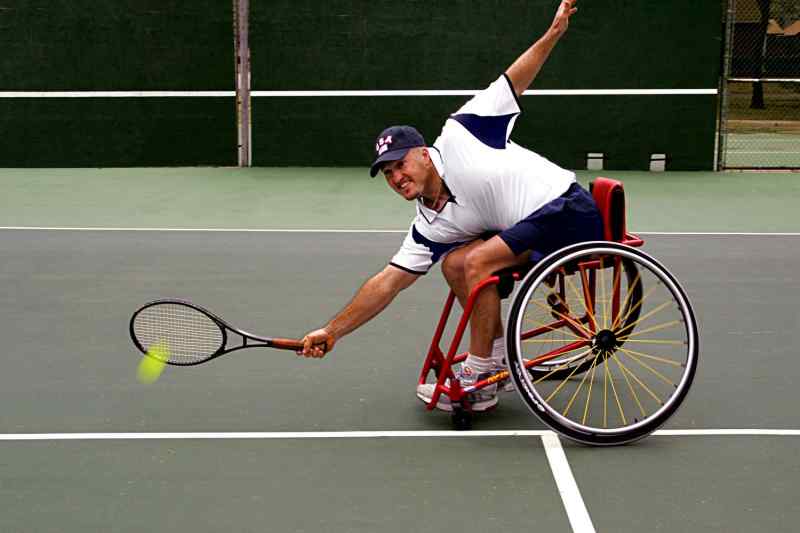Game, set, match!
What do you know about wheelchair tennis? You’ve undoubtedly heard of Wimbledon with its infamous strawberries and cream and celebrity spectator crowd, but one of the most popular adaptive sports out there, the thrill of being outdoors whilst keeping fit and active, and having the opportunity to even play doubles with a partner is often what appeals to many disabled people when it comes to wheelchair tennis. Many people take it up as their first disability-specific sport, in fact – thanks Wimbledon!
But, how is it played? Well, first things first, when considering the rules of the game, they are almost (but not quite!) identical to the running game. The one major difference to the standard ITF rules of tennis is that player is allowed two bounces of the ball before returning it, instead of only one bounce. However, it is only the first bounce that is required to be in the court of play.
Ready to get going? You may have a lot of questions before starting to play it, but here are five of the most important considerations:
Wheelchair Tennis Basics
- Is wheelchair tennis for manual wheelchairs only? No! This is possibly the best part about wheelchair tennis. Not only can it be played in either a manual or power wheelchair, but it can also be played with non-wheelchair users. Any of your friends or family members can choose to play wheelchair tennis with you without having to adjust the rules.
- Are there different categories for playing? There are three categories: Quads, Men, and Women. All of the categories offer doubles or singles tournaments.
- How can Quads hold a racquet? People with quadriplegia use tape to help secure the racquet to their hand. Modifications like this go along with the allowance of power chairs for people who need them.
- Is it played on a special court? No. That’s one of the things that makes it so much like traditional tennis. No changes are made to regulation lines or the court size. Equipment, such as racquets and balls are also the same as what you would use in any tennis game.
- Are there any differences between wheelchair tennis and traditional tennis? There is one significant rule change for wheelchair tennis, as stated above. The individual in the wheelchair can allow the ball to bounce twice, before having to hit it. The second bounce can even be outside the boundary lines. Clever, hey?
- When it comes to losing points, according to the official rules, this happens when:
- The player fails to return the ball before it has touched the ground three times; or
- Subject to the rule below with propelling the chair. The player uses any part of his feet or lower extremities as brakes or as stabilizers while delivering service, stroking a ball, turning or stopping against the ground or against any wheel while the ball is in play; or
- The player fails to keep one buttock in contact with his wheelchair seat when contacting the ball. Wheelchair/Able-bodied Tennis (USTA/ITF)
Where a wheelchair tennis player is playing with or against an able-bodied person in singles or doubles, the Rules of Wheelchair Tennis shall apply for the wheelchair player while the Rules of Tennis for able-bodied tennis shall apply for the able-bodied player. In this instance, the wheelchair player is allowed two bounces while the able-bodied player is allowed only one bounce. Note: The definition of lower extremities is: -the lower limb, including the buttocks, hip, thigh, leg, ankle and foot.
So, where did it all begin?
1976 is the year to remember, when wheelchair tennis came to fruition in the USA. It was developed and promoted by two American wheelchair tennis players, Brad Parks and Jeff Minnenbraker. So, we have a lot to thank them for!
Twelve years later, in 1988, the Paralympic Games were held in Seoul and wheelchair tennis was given a shot as a demonstration sport, moving onto full medal status in 1992 in Barcelona. Quad singles and doubles events took a little longer to make their debut, and shone brightly at the Athens 2004 Paralympics.
And, believe us, it’s fun to watch!
The movement and positioning skills of the wheelchair using players is really something to see. Pair that with some amazing rallies and serious racket skills, and you have yourself an incredibly exciting sport! You might even know some famous names in the
wheelchair tennis circuit: Scotland’s Gordon Reid won a gold medal in the Rio 2016 Paralympic Games, and is currently 7th in the world, with Argentinian Gustavo Fernandez currently enjoying a taste of the number 1 world ranking spot.
So, you want to play?
Time to swot up on the scoring of tennis (remember the difference between your ‘love’ and ‘advantage’!) and get used to a tennis wheelchair. There’s some great skills that can be learned here, including how to pick up tennis balls and keep some spare ones for after a dodgy serve – all in your wheelchair wheels!
What Next?
If you are ready to get serving and rallying, and are interested in learning more about what wheelchairs may be best to use for enjoying this sport, check out the Invacare Top End Pro Tennis Wheelchair online. You can see what type of features and adjustability are available to help you play your best game.
Parts of this post are based on information found in the article, Wheelchair Tennis-Top 5 Questions, by Roll Rev.
Author: Annie Beth Donahue is a professional writer with a health and disability focus.
